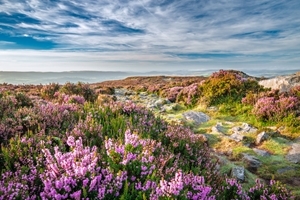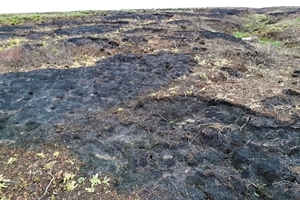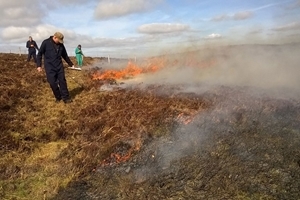This research paper was written by scientists outside the GWCT. Burning on peatlands is a topic of ongoing academic debate, and this article is not to be considered in isolation. For an in-depth summary of burning and peatland management, please read the GWCT’s Peatland Report. This report looks at carbon management in the English uplands, in particular on areas managed for grouse with an emphasis on vegetation management through burning. You can download it here or buy a hard copy here.
Key points
- Peatlands are important for carbon storage, holding as much carbon as the world’s vegetation.
- Many of the world’s peatlands are shaped by regular wildfires, which range in severity and effect. This study looks at the impact of less severe fires on the carbon storage potential of peat.
- These fires can stabilise carbon stores in the peat by altering the chemistry of organic matter in the soil.
- In laboratory experiments, peat samples exposed to low-severity fires produced less carbon dioxide (CO2) over time, with lower emissions after 1-3 years.
- The changes caused by fire made organic matter in the peat more stable, and less likely to decompose in the future. This allowed the peat to retain more of its stored carbon.
- Low-severity fire is an overlooked factor in the carbon cycle of peatlands.
Background
 Peat is formed by the build-up of dead vegetation or other organic matter, which is compressed and preserved therefore storing its carbon. Certain plant species, such as mosses and sedges that grow in waterlogged conditions, are particularly good at forming peat. As plants grow, they take in carbon dioxide from the atmosphere and it becomes part of the structure of the plant. When this vegetation dies, the carbon is retained as long as the plant does not decompose – which would release the carbon back to the atmosphere. If the soil is saturated with water and there is less oxygen available, this will prevent decay and the vegetation remains are slowly compressed as more material falls each season, building layers that eventually turn into peat. The peat is deepest where wet conditions are maintained, and it can take thousands of years to form a deep layer.
Peat is formed by the build-up of dead vegetation or other organic matter, which is compressed and preserved therefore storing its carbon. Certain plant species, such as mosses and sedges that grow in waterlogged conditions, are particularly good at forming peat. As plants grow, they take in carbon dioxide from the atmosphere and it becomes part of the structure of the plant. When this vegetation dies, the carbon is retained as long as the plant does not decompose – which would release the carbon back to the atmosphere. If the soil is saturated with water and there is less oxygen available, this will prevent decay and the vegetation remains are slowly compressed as more material falls each season, building layers that eventually turn into peat. The peat is deepest where wet conditions are maintained, and it can take thousands of years to form a deep layer.
There are peatlands across the world, found in a variety of envrionments, often with fresh water and cool, wet climates. Canada and Russia have the largest areas of peatlands, but they are also found in Northern Europe. In cooler climates, sphagnum moss is an important part of peat development, thriving in wet conditions.
Peatlands are an important part of the ecosystem, containing one of the earth’s largest terrestrial stores of carbon. This has occurred over time through the gradual accumulation of additional layers over thousands of years. As peat creation is a slow process, restoring what is lost when it is damaged will require many years.
 Any fire will damage peatland vegetation, but the nature of this damage and how the vegetation responds is important. Peatland fires have an important impact on global carbon stores, with recent literature showing that peat fires account for 15% of annual global greenhouse emissions.
Any fire will damage peatland vegetation, but the nature of this damage and how the vegetation responds is important. Peatland fires have an important impact on global carbon stores, with recent literature showing that peat fires account for 15% of annual global greenhouse emissions.
Wildfires range in severity from those that are lower temperature and pass quickly across the soil, to those that are more severe, producing very high temperatures, which can ignite the underlying peat and cause massive carbon loss. When used as part of peatland management, practitioners aim to replicate cool burns, which involve the plant canopy with little effect on the ground layer and the peat itself. However, if the fire becomes hotter and unmanageable, it can escape control and act like wildfire. These burns produce more heat and affect growing plants and debris. This can lead to damage and ignition of the underlying peat, with temperatures becoming higher and the fire uncontrollable. If the peat is burnt, it can cause severe damage and a loss of carbon. These below-ground fires are likely to occur during periods of drought or where the area has been drained.
For either wildfire or management fires, a low-severity fire has a lower temperature or a short-term effect on the ecosystem. It removes a layer of vegetation, therefore reducing the available fuel left, but a limited amount of peat under the surface is affected. The soil surface and up to a few centimetres below is heated rapidly, which can alter the organic matter within the soil and create a more stable form of carbon.
This study looked at the effect that low-severity fires can have on the chemistry of the carbon in organic matter near the surface and studied whether this affects carbon loss. It also looks at how low-severity fires affect the peat in the long term.
What they did
The scientists examined four peatlands located in North and South America to study the effect of low-severity fires on a range of different types of peatland. These sites vary widely, including shrub bog, spruce forest peatland, tropical environments and wetlands, with different species predominating in the peat composition.
The scientists took samples from these sites and took them to the lab, where they used a furnace to replicate the soil temperatures recorded during low-severity prescribed fires.
They used different analytical techniques to study the response of the soil samples, looking at the soil moisture, physical changes in soil structure, and chemical changes to carbon within the soil organic matter as well as the amount of carbon released afterwards (as carbon dioxide (CO2) gas).
What they found
Using an electron microscope as well as chemical analysis to examine the effects of fire in detail, the scientists saw charring on the peat surface and found a more stable form of carbon present on the organic matter in the samples after heating. Chemical analysis showed that this change means the soil carbon cannot easily be oxidised, converted to carbon dioxide and released. Therefore, there was a more stable form of carbon present on the surface of the organic matter that was left in the carbon stores.
X-ray spectroscopy analysis of the surface chemistry showed hydrophobic groups on the surface of the soil, creating low water solubility and providing the possibility for persistence in soil affected by fire.
When studying carbon dioxide release, those that had been burnt initially had higher emissions compared to the unburnt peat, but after 15 days, the emissions from burnt samples were less than unburnt samples. The scientists calculated from this that the cumulative amount of carbon dioxide over 1-3 years would be less in the burnt peat samples. Furthermore, the burnt peat soils were less susceptible to changes in temperature, and the heat altered the profile of the bacteria, restricting microbial access to the organic matter and therefore reducing decomposition of the peat. This reduction in temperature sensitivity is important for peatland response to climate change.
What does this mean?
 These results support the idea that low-severity fires can help organic matter in peat survive and better protect the carbon stores from decomposition. Such low-severity fires can stabilise carbon contained in the peat and prevent its loss as carbon dioxide while causing little change overall to the chemistry of the peat. These fires created a coating on the surface of the peat that resists water with minimal structural changes to the soil.
These results support the idea that low-severity fires can help organic matter in peat survive and better protect the carbon stores from decomposition. Such low-severity fires can stabilise carbon contained in the peat and prevent its loss as carbon dioxide while causing little change overall to the chemistry of the peat. These fires created a coating on the surface of the peat that resists water with minimal structural changes to the soil.
This is important to reduce post-fire evaporation and prevent exposure of the carbon stock. Maintaining the water and preventing loss through evaporation will also help prevent severe fires, which can be caused by dehydration of the peatlands, leading to damage of the carbon stores in the peat. These low-severity fires can increase resistance to water and create an insulating layer.
There is strong evidence that the chemistry of the soil surface is significantly altered by the heat of the fire. This temperature change at the surface reduced the rates of microbial respiration by limiting their access to organic matter. This can reduce the amount of CO2 released, and also make the soil and the microorganisms within it less sensitive to temperature changes – an important possibility when considering climate change.
This change may increase the stable carbon found in the layers of peat and increase the proportion of organic matter that persists. This process of low-severity fire is an underestimated, yet potentially important part of the global carbon cycle in peatlands.
Although this research was conducted in North and South America in a variety of different environments that are not heather-based, the information gained remains important to understanding burning on peatlands and the impact this has on the environment and on carbon stores within peat. Section 5 of the recent GWCT Peatland Report discusses the lessons we can learn from the USA in managing fire. Point 7.7 discusses prescribed fires in the USA and the impact. Point 7.9 discusses the future in terms UK fires and the lessons we can learn from the USA.
7.7. Notable exceptions have been in regions where intentional prescribed fire has continued. High frequency, low intensity prescribed, or managed fires maintain substantial local and regional plant and animal biodiversity and complement timber management and other land uses. The effects of prescribed fire on reducing wildfires, results have been overwhelmingly in favour of drastic reductions in wildfire where prescribed fires are common.
7.9. The USA experience with fire suppression is one potential path for managing fire-prone ecosystems. Changes in climate, particularly warming and its effects on wildfires is a complicating facet that will likely exacerbate the simplistic policy of reduced burning. Predicting a future without fire in UK’s moorlands is complicated, but lessons learned in the USA and in other fire-prone regions of the globe suggest that finding ways to manage fire for biodiversity, wildfire hazard reduction, and carbon storage is an important strategy for long-term sustainability.
Read the original paper
Flanagan, NE, Wang, H, Winton, S, Richardson, CJ. Low‐severity fire as a mechanism of organic matter protection in global peatlands: Thermal alteration slows decomposition. Glob Change Biol. 2020; 00: 1-17.
References
- Gillingham, P., Stewart, J. & Binney, H. (2016). The historic peat record: Implications for the restoration of blanket bog (NEER011).
- Shepherd, M.J., Labadz, J., Caporn, S.J., Crowle, A., Goodison, R., Rebane, M. & Waters, R. (2013). Restoration of degraded blanket bog (NEER003).
- Craft, C. (2016). Peatlands. In: Creating and Restoring Wetlands: 161–192. doi:10.1016/b978-0-12-407232-9.00007-5
- Larmola, T., Tuittila, E.S., Tiirola, M., Nykänen, H., Martikainen, P.J., Yrjälä, K., Tuomivirta, T. & Fritze, H. (2010). The role of Sphagnum mosses in the methane cycling of a boreal mire. Ecology, 91:2356–2365.
- Rein, G. (2015). Smoldering-peat megafires. In: Coal and peat fires: A global perspective: 1–11. (eds. Stracher, G.B., Prakash, A. & Rein, G.)
- Grau-Andrés, R., Davies, G.M., Waldron, S., Scott, E.M. & Gray, A. (2017). Leaving moss and litter layers undisturbed reduces the short-term environmental consequences of heathland managed burns. Journal of Environmental Management, 204:102–110.
- Turetsky, M.R., Kane, E.S., Harden, J.W., Ottmar, R.D., Manies, K.L., Hoy, E. & Kasischke, E.S. (2011). Recent acceleration of biomass burning and carbon losses in Alaskan forests and peatlands. Nature Geoscience, 4:27–31.
- Rein, G., Cleaver, N., Ashton, C., Pironi, P. & Torero, J.L. (2008). The severity of smouldering peat fires and damage to the forest soil. Catena, 74:304–309.
- Wilkinson, S.L., Verkaik, G.J., Moore, P.A. & Waddington, J.M. (2020). Threshold peat burn severity breaks evaporation-limiting feedback. Ecohydrology, 13:1–11.
- Davidson, E.A. & Janssens, I.A. (2006). Temperature sensitivity of soil carbon decomposition and feedbacks to climate change. Nature, 440:165–173.
- Rogers, B.M., Balch, J.K., Goetz, S.J., Lehmann, C.E.R. & Turetsky, M. (2020). Focus on changing fire regimes: interactions with climate, ecosystems, and society. Environmental Research Letters, 15:30201.
- GWCT. (2020). Peatland Report 2020: A review of the environmental impacts including carbon sequestration, greenhouse gas emissions and wildfire on peatland in England associated with grouse moor management.